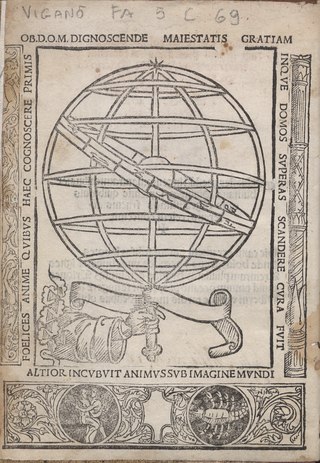
Peter of Bergamo also called Peter of Almadura (1400 ca. - 1482) was an Italian Dominican theologian. [1]

Peter of Bergamo also called Peter of Almadura (1400 ca. - 1482) was an Italian Dominican theologian. [1]
Born in Bergamo in the early 15th century, he entered the Dominican Order in his native town, and completed his studies at the University of Bologna, where he received his degree. In the Dominican House of Studies he filled the offices of Master of Students and Bachelor of the Studium.
He died in Piacenza in 1482. The people of Piacenza venerated him as a saint, and Leandro Alberti states that miracles were wrought through his intercession. His remains were deposited in a crypt under the high altar of the chapel of St. Thomas. [1]
All of his surviving writings deal with the works of Thomas Aquinas: "Index universalis in omnia opera D. Th. de Aquino" (Bologna, 1475) and "Concordantiæ locorum doct. Angel. quæ sibi invicem adversari videntur" (Basle, 1478), combined under the title, "Tabula in libros . . . cum additionibus conclusionum, concordantiis locorum et S. Script. auctoritatibus" (Venice, 1497; Rome, 1535).
In the edition of St. Thomas's works published by order of Pius V all Almadura's indices, etc. appear under the name: "Tabula aurea exim. doct. Fr. Petri de Bergamo . . . in omnes libros, opuscula et commentaria D. Th. Aquin. . . ." (Rome, 1570). This "Tabula aurea" was republished as vol. XXV of the Parma edition of St. Thomas's works (Parma, 1873).

Agostino Carracci was an Italian painter, printmaker, tapestry designer, and art teacher. He was, together with his brother, Annibale Carracci, and cousin, Ludovico Carracci, one of the founders of the Accademia degli Incamminati in Bologna. Intended to devise alternatives to the Mannerist style favored in the preceding decades, this teaching academy helped propel painters of the School of Bologna to prominence.

Pope Innocent V, born Pierre de Tarentaise, was head of the Catholic Church and ruler of the Papal States from 21 January to 22 June 1276. A member of the Order of Preachers, he acquired a reputation as an effective preacher. He held one of the two "Dominican Chairs" at the University of Paris, and was instrumental in helping with drawing up the "program of studies" for the Order. In 1269, Peter of Tarentaise was Provincial of the French Province of Dominicans. He was a close collaborator of Pope Gregory X, who named him Bishop of Ostia and raised him to cardinal in 1273.

Piacenza is a city and comune (municipality) in the Emilia-Romagna region of Northern Italy, and the capital of the eponymous province. As of 2022, Piacenza is the ninth largest city in the region by population, with more than 102,000 inhabitants.

Peter of Verona, also known as Saint Peter Martyr and Saint Peter of Verona, was a 13th-century Italian Catholic priest. He was a Dominican friar and a celebrated preacher. He served as Inquisitor in Lombardy, was killed by an assassin, and was canonized as a Catholic saint 11 months after his death, making this the fastest canonization in history.

Paul of Venice was a Catholic philosopher, theologian, logician and metaphysician of the Order of Saint Augustine.

Sylvester Mazzolini, in Italian Silvestro Mazzolini da Prierio, in Latin Sylvester Prierias (1456/1457–1527), was a theologian born at Priero, Piedmont; he died at Rome. Prierias perished when the imperial troops forced their way into the city, leading to the Sack of Rome.

Sebastiano Ricci was an Italian painter of the late Baroque school of Venice. About the same age as Piazzetta, and an elder contemporary of Tiepolo, he represents a late version of the vigorous and luminous Cortonesque style of grand manner fresco painting.
Aymeric of Piacenza was an Italian Dominican scholar, who became Master of the Order of Preachers. He was involved in both the suppression of the Fraticelli, and the downfall of the Templars.
Nicolas d'Orbellis was a French Franciscan theologian and philosopher, of the Scotist school.

The Diocese of Guastalla was a Catholic suffragan bishopric in the province of Reggio Emilia, Italy, from 1828 to 1986. It began as a small chapel, ordered by a Holy Roman Emperor in 865; it was promoted into being a parish; it then became a territorial abbey; and finally, after the Napoleonic occupation of Italy, it was made a diocese at the request of his second wife. The diocese employed the Roman rite.
Casto Innocenzio Ansaldi was an Italian professor, theologian and archaeologist.

The Diocese of Fidenza is a Latin diocese of the Catholic Church in the Province of Parma, Italy. It was until 1927 named the Diocese of Borgo San Donnino. It is now a suffragan of the Metropolitan Archdiocese of Modena-Nonantola, though historically it was long subject to the Archdiocese of Bologna.

The Diocese of Piacenza-Bobbio is a Latin diocese of the Catholic Church. It has existed since 1989. In northern Italy, it is a suffragan of the Archdiocese of Modena-Nonantola. The historic Diocese of Piacenza was combined with the territory of the diocese of Bobbio-San Colombano, which was briefly united with the archdiocese of Genoa.
Francesco Silvestri, O.P. was an Italian Dominican theologian. He wrote a notable commentary on Thomas of Aquinas's Summa contra gentiles, and served as Master General of his order from 1525 until his death.
Bartolomeo Spina was an Italian Dominican theologian and scholastic philosopher.
Serafino Porrecta was an Italian Dominican theologian.
Bartolommeo Fumo was an Italian Dominican theologian.
Pietro Bertani (1501–1558) was an Italian Roman Catholic bishop and cardinal.

Dominic of Flanders was a French-Flemish Dominican philosopher and Scholastic author, known to have been a renowned Thomist. His commentaries on Aristotle and on Thomas Aquinas were frequently printed, the most famous being his commentary on Aristotle’s Metaphysics. This Commentaria is commonly known to have been dedicated to Lorenzo de’ Medici.
Pietro Perreau was an Italian librarian and Hebraist.